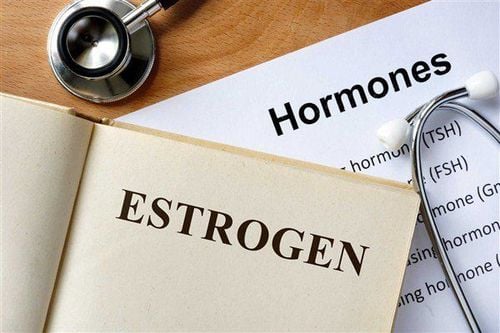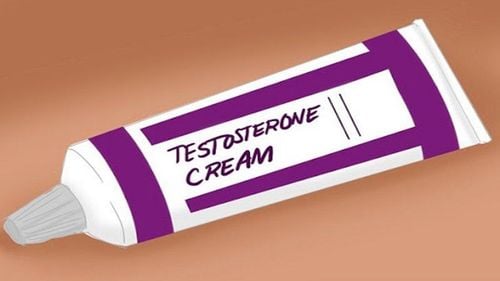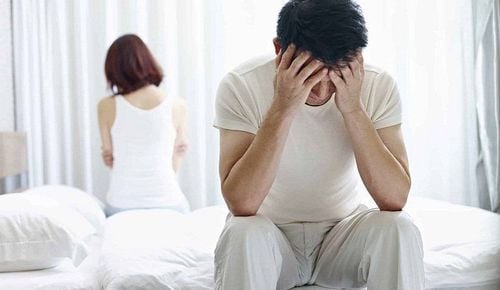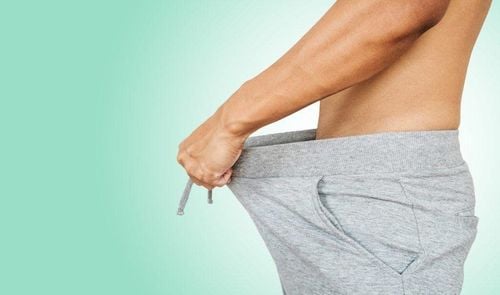This is an automatically translated article.
Male hypogonadism, also known as testosterone deficiency, is when the testes limit the production of the male sex hormone testosterone or decrease sperm count or both. This condition affects many organ system functions and can also have a negative impact on a man's quality of life. Therefore, early detection of signs of male hypogonadism and timely intervention is very important.
1. What is male hypogonadism?
Male hypogonadism is a condition in which the body does not produce enough of the hormone that plays a major role in the growth and development of the male factor during puberty (testosterone) or the production of an adequate number of sperm. or both.
A man can develop male hypogonadism at birth or possibly later in life as a result of trauma or infection. At this point, corrective interventions in male hypogonadism will depend on the cause of the disease and when it occurs in life. In it, testosterone replacement therapy will play a key role.

Mức testosterone sản xuất không đủ khiến suy sinh dục nam diễn ra sớm hơn
2. Symptoms of male hypogonadism
Male hypogonadism can begin during fetal development, before puberty or during adulthood. Accordingly, signs and symptoms will depend on the stage of the disease throughout life.
2.1 During the fetal stage
If the body does not produce enough testosterone during the formation and development of the fetus, as a result, the external sex organs will be limited. Depending on the time of hypogonadism and the amount of testosterone produced, the child is still male but may be born with:
Female genitals; The genitals are not clearly male or female; Underdeveloped male genitalia
2.2 During puberty
Men with hypogonadism may have delayed puberty or incomplete development of organs in the body, most affecting muscle mass, deep voice, body growth rate, amount of facial hair face, pubic hair and especially the growth of the penis and testicles.
Accordingly, secondary sexual characteristics will be underdeveloped. Adolescents have a shorter height, smaller muscle size, similar to the penis and testicles. In some cases, there are even high voices, sparse hair and hair, and emulsification of the mammary glands.
2.3 During adulthood
In adult men, hypogonadism acquired at this time can still alter some of the male physical characteristics and impair reproductive function. Early signs and symptoms suggestive of male hypogonadism include:
Decreased libido; Always feel lack of energy; Fatigue, depression. Over time, men with hypogonadism can lead to:
Erectile dysfunction; Reduce the amount of beard, hair, and hair on the face and body; Decrease in muscle mass and size; Increased breast tissue growth causes mammary gland emulsification; Loss of bone mass causes osteoporosis. Severe hypogonadism can also cause mental and emotional changes. When testosterone drops, some men experience symptoms similar to menopause in women, like hot flashes and difficulty concentrating.
3. Causes of male hypogonadism
Male hypogonadism is defined as when the testicles do not produce enough of the male sex hormone testosterone. From there, male hypogonadism is classified into two basic groups according to the cause of the disease:
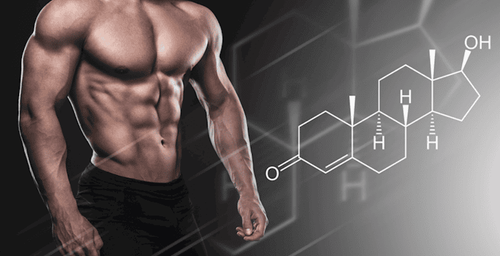
Testosterone thấp khiến nam giới bị rối loạn cương dương
3.1 Primary male hypogonadism
This type of hypogonadism is caused by problems occurring directly in the testicles. Common causes of primary hypogonadism include:
Klinefelter syndrome : This condition is caused by congenital abnormalities of the X and Y sex chromosomes. A male usually has one X and one chromosome. Y chromosomes form a pair of sex chromosomes. In Klinefelter syndrome, the patient will have two or more X chromosomes in addition to one Y chromosome.
It is the Y chromosome that contains the genetic material that determines the male sex of a child born with development. of relevant parts. An extra X chromosome in Klinefelter syndrome causes abnormal development of the testicles; which in turn leads to a lack of testosterone production.
Testicles do not move downward: During fetal life, the testicles develop inside the abdomen and usually move down to their permanent location in the scrotum just before birth. Hypogonadism occurs when one or both testicles do not descend at birth.
This condition usually resolves on its own within the first few years of life without any treatment. However, if not actively corrected early, even within a few days of giving birth, testicular health will suffer and testosterone production will decrease.
Mumps: Complicated mumps infections to the testicles that occur during adolescence or adulthood can impair testicular function and testosterone production.
Congenital hemolytic disease: Consequences when too much iron in the blood due to hemolysis can cause testicular failure or pituitary dysfunction, affecting testosterone production.
Injury to the testicle: Because it is outside the abdomen, surrounded by a loose layer of tissue, the testicles are prone to injury. After the injury, although the testicles still develop normally, there is still a risk of hypogonadism. However, damage to one testicle still may not decrease total testosterone production overall.
Cancer treatment: Chemotherapy or radiation therapy for cancer can interfere with testosterone and sperm production. While the effects of both of these treatments on other organ systems are usually temporary, permanent infertility can still occur.
3.2 Secondary male hypogonadism
In secondary male hypogonadism, perfectly normal testicles but not working properly are caused by problems with the pituitary gland or the hypothalamus - the parts of the brain that control the testes' production of testosterone. Several conditions can cause secondary hypogonadism, including:
Kallmann syndrome: This is an abnormal growth of the area of the brain that controls pituitary hormone secretion in the hypothalamus. This syndrome can also affect the ability to smell and cause red-green color blindness in men. Pituitary dysfunction: Abnormalities in the pituitary gland can reduce the release of control hormones from the pituitary gland to the testes, affecting testosterone production. The trigger can be a pituitary tumor or any other brain tumor located near the pituitary gland. On the other hand, treating a brain tumor, such as with surgery or radiation, can still affect the pituitary gland and cause male hypogonadism.
Inflammatory diseases: Some inflammatory diseases such as sarcoidosis, tuberculosis... to the hypothalamus and pituitary gland can affect testosterone production. Even the agent HIV/AIDS, the virus leads to low testosterone levels by infecting the hypothalamus, pituitary gland and testes.
Drugs: The use of certain drugs, such as opiates and some exogenous hormones, can affect testosterone production.
Obesity: Significantly overweight at any age may be associated with male hypogonadism.
Aging: As a man ages, the production of testosterone gradually decreases. However, the incidence and rate of decline are individual.
4. Complications of male hypogonadism
Similar to symptoms, the complications of male hypogonadism, if left untreated, will vary depending on when it is acquired – from fetal development and growth to puberty or mature.
Complications may include:
Abnormal genital formation; Large breast size, mammary gland emulsification; Erectile dysfunction; Osteoporosis ; Depression .

Suy sinh dục nam có thể dẫn đến trầm cảm nghiệm trọng
5. How is male hypogonadism diagnosed?
Early detection of hypogonadism in boys can help prevent problems from delayed puberty. Besides, benefits from early diagnosis and treatment in men also help protect better health, against osteoporosis and other diseases.
To do so, your doctor will conduct a physical examination and evaluate your sexual development, such as pubic hair, muscle mass and testicle size, is appropriate for your age or not. As a next step, blood testosterone levels will be measured if the patient does indeed have signs or symptoms of hypogonadism. Because testosterone levels fluctuate widely throughout the day and are often highest in the morning, blood samples are usually taken early in the day, before 10 a.m.
If testosterone levels are noted to be low, additional tests will be performed to find the cause of testicular or pituitary abnormalities, including:
Hormone testing; Semen analysis; Pituitary imaging; Genetic research; Testicular biopsy.
6. How is male hypogonadism treated?
Treatment of testosterone deficiency in boys will depend on the underlying cause. Testosterone supplementation will take three to six months to stimulate puberty and the development of secondary sex characteristics, such as increased muscle mass, beard growth, pubic hair growth, and positive growth. object.
In adult men, male hypogonadism is often treated with testosterone replacement to bring testosterone levels back to normal. Testosterone may help improve the signs and symptoms of male hypogonadism, such as decreased sex drive, decreased energy, decreased facial and body hair, and loss of muscle mass and bone density.
For older men, low doses of testosterone can still be used if there are signs of hypogonadism due to aging. However, the benefits of this testosterone replacement are still unclear.
Testosterone preparations come in many forms, from oral capsules, intramuscular injections to topical gels, patches, implants or chewing gum. However, during the use of testosterone, endocrinologists recommend monitoring the effectiveness of treatment and side effects several times during the first year of treatment and annually thereafter. Because, testosterone therapy also contains many risks such as increased red blood cell production, acne, sleep disorders, prostate enlargement ....
Besides, some lifestyle changes still exist. can help increase testosterone levels, prevent male hypogonadism such as losing weight, exercising, reducing stress, getting enough sleep, avoiding alcohol, quitting smoking...
In short, despite the awareness of hypogonadism The number of adult males with this condition who are properly diagnosed and treated is still limited. Patients need to find a reputable and quality male specialist to receive the best treatment support.
>> See more: Male hypogonadism (reduced testosterone secretion) - A disease that is often forgotten - Written by resident doctor Trinh Ngoc Anh - Department of Internal Medicine - Vinmec Times City International Hospital
Please dial HOTLINE for more information or register for an appointment HERE. Download MyVinmec app to make appointments faster and to manage your bookings easily.
Reference source: medicalnewstoday.com; clevelandclinic.org





